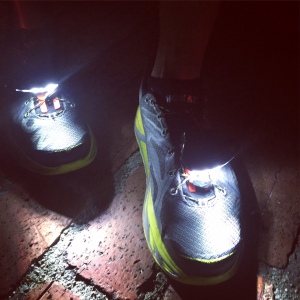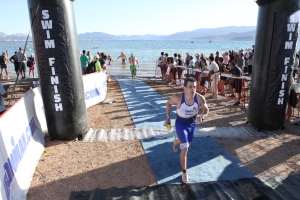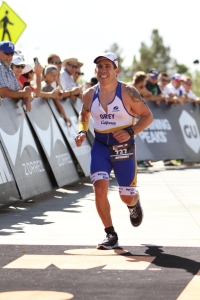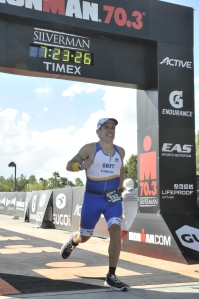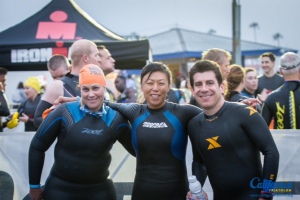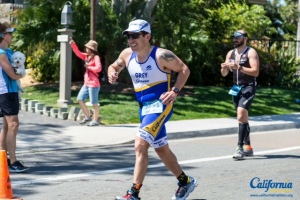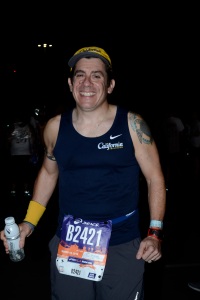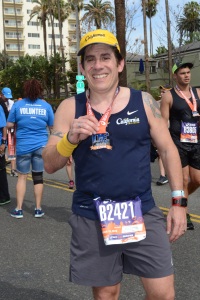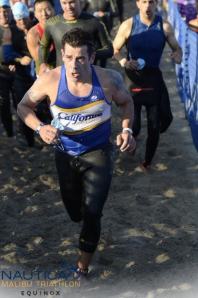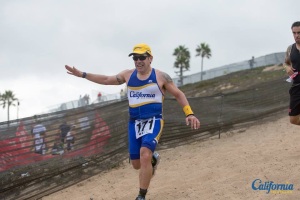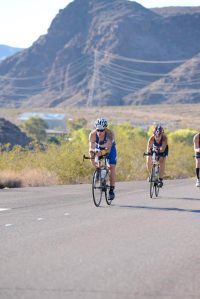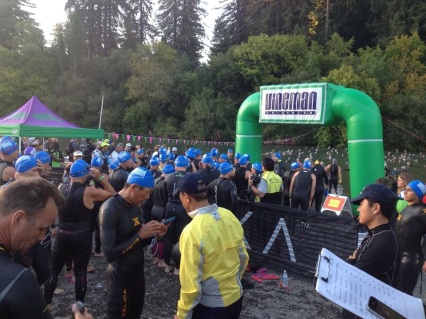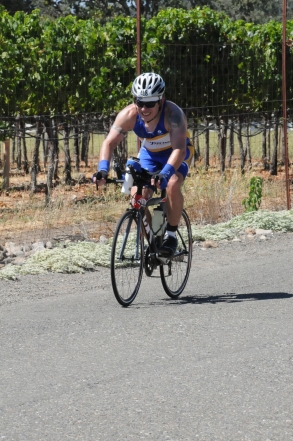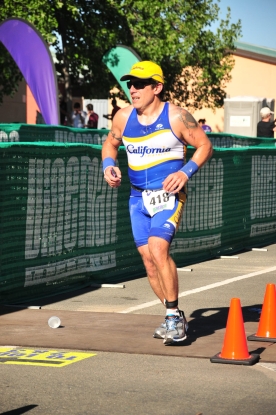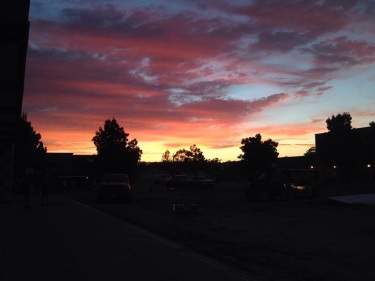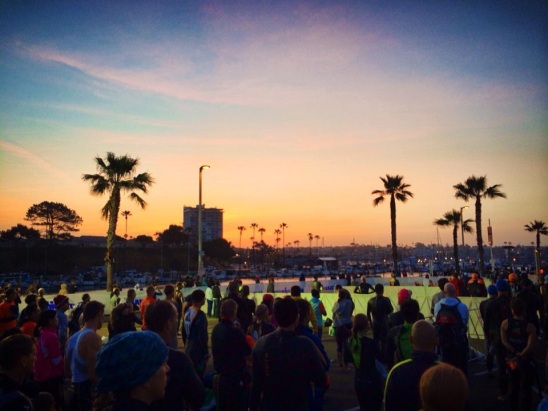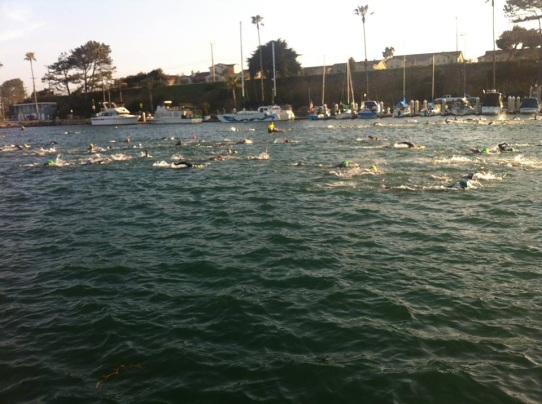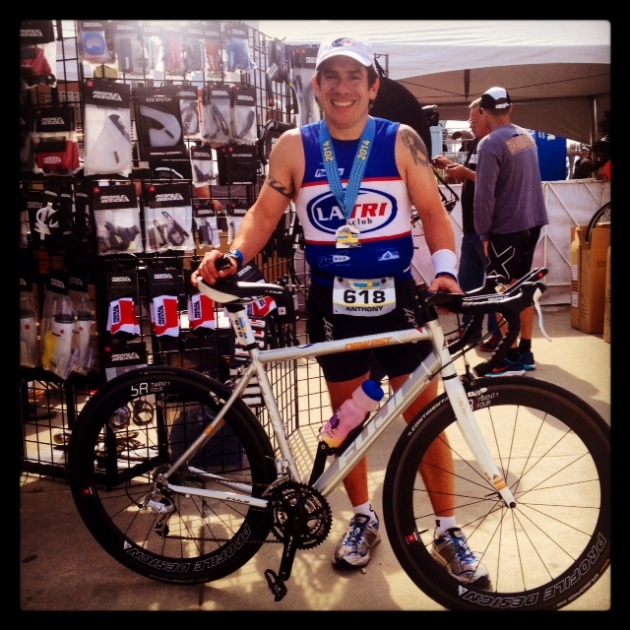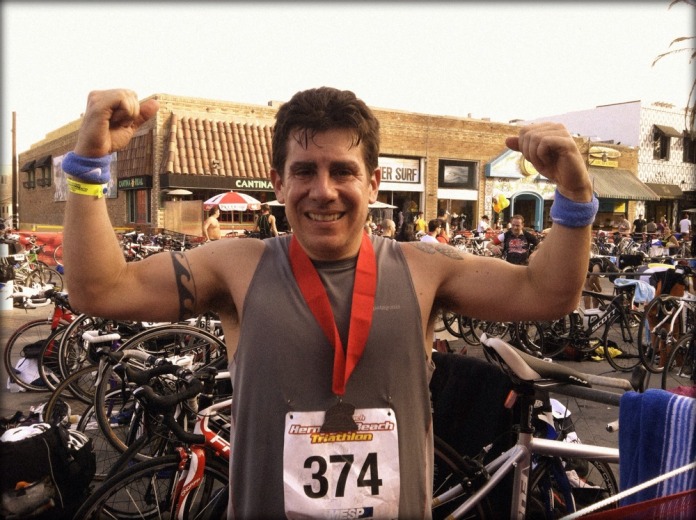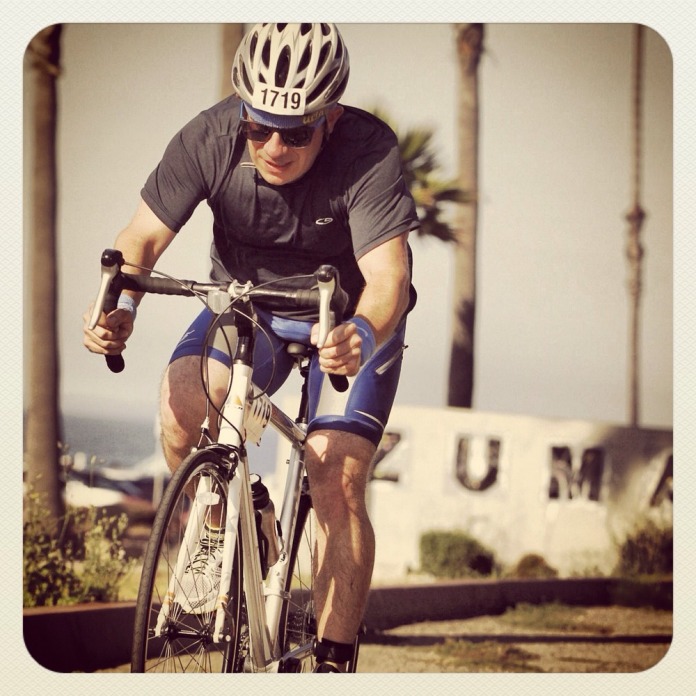It’s been four days since I crossed the finish line at Ironman Arizona. I’ve had plenty of time, including a long drive with traffic delays back to LA, to reflect on my experience, my preparation, and everything that goes into such an undertaking. Now I’m ready to share my thoughts. This could take a while, so grab a cup of coffee and settle in with me. Thanks!
A little background, for the uninitiated
Triathlons range in distance, with the most commonly used terms and classifications being sprint, Olympic, half and full. The Olympic distance is a 1.5 km (.93 mile) swim, 40 km (24.8 mile) bike, and 10 km (6.2 mile) run. Sprints are shorter, often ending in a 5 km (3.1 mile) run. Sprint and Olympic distance races are collectively referred to as “short course” triathlons. While shorter distances are typically the starting point for beginning triathletes, to suggest that these races are “easier” is a misnomer. At the elite levels, athletes push hard and red-line it the whole way. These races require a different strategy and approach.
“Full,” “full distance,” “140.6,” “Iron distance,” or “Ironman” all refer to a triathlon consisting of a 2.4 mile swim, 112 mile bike, and 26.2 mile run (a “half” just cuts all of those distances in half so 1.2 swim/56 bike/13.1 run for a total of 70.3). Events that are longer than Olympic distance are collectively referred to as “long course” triathlons. The elites can finish a full distance race in less than 9 hours, but all are given up to 17 hours to complete the race. In any case, it’s a long day and much more about managing effort, adjusting to conditions, and sometimes just summoning the will to keep putting one foot in front of the other.
I started out in triathlons swimming 1/4 mile on a relay team in a sprint distance race about 5 years ago. I never imagined at the time that I would be capable of coming back to do all three legs of the race by myself, let alone move to Olympic, half, and full distance, but that’s what happened. I did the relay a few times, got much more comfortable swimming in the open water, and resolved to start doing the complete race once I’d finished my MBA program. Family and friends thought a single go at the sprint distance race would be sufficient for me to cross an item off the bucket list, but I fell in love with the sport, and with the physical and psychological benefits of training and racing. So I started signing up for more races, moved up to Olympic distance and longer races. Running my first marathon in January of 2014 gave me the confidence I needed to commit to signing up for a Full.
On July 26, 2014, I finished the Full Vineman triathlon up in Northern California’s Sonoma wine region. It was still an independent race at the time, not owned by World Triathlon Corporation (which owns the “Ironman” brand, name and logo) but the distance was the same and at the end of the day I could still call myself an Ironman. For the first one, my goal was simply to finish. I struggled in the extreme heat, fought through a nutritional crash and a bad ankle to get it done in just over 15 hours. You can read more about my experience at that race here. Suffice it to say, I learned a lot about myself and how I needed to train, prepare, and visualize for the next one.
Flash forward to 2015. I did fewer races overall this year but kept enough on my calendar including a few big endurance tests so that I could never exit training mode for long. Having a big race this late in the year is kind of a drag. The days are shorter and you still need to train. It gets colder and lonelier. But I enjoyed tremendous support from my California Triathlon teammates and coaches. We did group training including race simulations and long brick workouts. In my approach to Ironman Arizona, I felt confident that I could finish because I’d covered the distance before (although…anything can happen on race day); I just wanted to race smarter, faster, and better than before. Sure I had an idea of a finish time goal in mind, right around 13 hours, but mostly I just talked about wanting to manage my effort on the bike so I could finish with a strong run.
There’s a lot that happens before the actual race: Logistical concerns about what to place in the various bags that you have to leave the day before, checking and double checking the bike and all of my gear, doing enough exercise to feel loose and ready but not sore. Early morning rituals including worrying about what to eat, how much, and when, frequent bathroom use, pacing in the transition area, sharing hugs and best wishes with friends, psyching myself up while just trying to keep calm. Before too long, I had the wetsuit on and stood in a crowd getting ready to enter the water and start a long day.
The Swim – 2.4 Miles – It’s a contact sport!
At Ironman Arizona, the swim is in Tempe Town Lake, which has a reputation for being kind of nasty (think water quality, bacteria, sewage, etc). I had done a short practice swim the day before. The water was cold (around 63 degrees) and visibility was poor, but it didn’t smell bad and I didn’t encounter any trash. Ironman races are known for the mass swim start, where all 2000+ athletes start in the water at the same time and it’s common to get elbowed and kicked, a lot. It can be very unsettling and potentially very dangerous. In an effort to alleviate some of the chaos, Ironman implemented a self-seeded rolling start, where athletes line up according to their projected finish time for the swim and enter the water in a continuous flow. I took my place close to the sign for 1 hour, 20 minutes. The crowd moved forward. I walked down the steps and entered the water a few minutes before 7 AM. Since I haven’t experienced the mass start, I can’t say if the rolling self-seeded start felt any different or better. What I can say is that there was plenty of body contact. It took several minutes of swimming before I could extend my stroke without touching someone else. I would find space for a little while, then it would close up as I overtook others or felt myself being pulled from behind. Whenever I felt like I was being crowded (which was often), I would speed up and try to create some distance. It didn’t always work. The fastest course is a straight line but I did my share of weaving to find space between swimmers and around buoys. Close to the finish, I heard my friend and teammate Chris Depew urging me on from his position atop one of the paddleboards (there to aid swimmers in distress). I pulled hard to the end and made my way up the stairs. From the clock, it looked like I’d taken around 1 hour, 24 minutes (officially 1:24:20), a little slower than my goal but good enough.
Volunteers (“wetsuit strippers”) helped us out of our wetsuits. I ran into transition across the muddy grass, exchanged a quick greeting with my friend and sometime coach Marek, grabbed my bike gear bag and headed into the crowded changing tent. I got my helmet and sunglasses on. I wiped the mud off my feet as best I could and put on my bike shoes. I wanted to move quickly but spent an extra minute to double check what I was taking with me, since I’d be on the bike for a long time. I put on some sunscreen, grabbed my bike, and trotted out of transition.
The Bike – 112 Miles – Wind, rain and hail!
A little more than halfway through at one of the aid stations, I overheard an athlete tell a volunteer “If Al Roker were here, I’d strangle him.” The forecasts before the race called for very little wind and a chance of showers starting in the late afternoon, well after most would have already started the run. Instead, we got a downpour around 11 AM. For me that was after a good 50 miles of riding. The bike course consists of three loops, a few turns going out of Tempe and then a long stretch on the Beeline Highway. There isn’t much climbing (around 1300 feet overall) but there’s a sustained uphill portion along the outbound portion of the Beeline, and it felt like we were riding into a headwind most of the way. Upon reaching the turnaround at the far end, there’s a downhill and a stretch where I would just hammer to go as fast as I could for as long as possible. As I said before, my strategy was to manage effort on the bike so I could save my legs for the run. I felt like I had my nutrition plan nailed. Food every 10 miles (mostly Barnana dried banana snacks and Effi Foods jasmine green tea & honey bars), gels or shot blocks every hour, Advil every 3 hours, and continuously sipping Invigorade until it was gone, then water with Gu hydration tabs. I stayed down on my aero bars most of the time, only popping up on the slow climb or to stretch out when it started to hurt. One restroom stop every loop. At first I felt like I needed to pee but couldn’t, so I kept drinking and eventually it got better. The rain started right around the halfway point for me. The ominous skies just opened up. On the fast section of my second loop, it felt like hailstones bouncing off of my bike helmet. The road became slick and I felt the need to adjust my speed just a little, especially on the turns, slowing my pedaling instead of applying my brakes. I was nervous about hydroplaning and crashing. Fortunately I didn’t see any crashes but I saw plenty of riders pulled off to the side to deal with flats and other mechanical issues; each time I’d tap my bike affectionately and say “Good Roo” (I ride a Quintana Roo bicycle, nicknamed Roo for short). After a while the rain would come and go. I’d think it was over then it would start up again, a steady drizzle closer to Tempe and a heavy downpour further out. I saw my friend and teammate Chris Corning at the Bike Special Needs stop, where I’d left a peanut butter sandwich, some additional Advil and other nutrition (though unfortunately nothing to keep me warm or dry). The volunteers were wonderful across the board. They were getting drenched too. Most were wearing trash bags. This wasn’t an easy day for anyone. I also found my friend & photographer extraordinaire Harrison staked out in a strategic spot to capture the best photos (including some of those posted here) for Cal Tri. I’d see him later on the run too.
Starting the third and final loop, 37 more miles and some change, feeling soaked and chilled, I put my head down and said out loud “One more. Just get it done.” I tried to find the middle ground between pushing for speed and spinning out the legs on those final miles. Taking the turn into transition, I felt so ready to get off the bike and I’d already started thinking about the run. The entire bike portion took me 6:43:24. I’d hoped to finish a lot closer to 6 hours, or even 6:30:00, but it was still a good 54 minutes faster over the 112 miles compared to my time at Vineman so I’ll take it. Think about finish lines more than finish times.
A volunteer took the bike, I grabbed my gear bag, and jogged into the changing tent for the bike to run transition, which felt more like a medical triage unit. Everyone was soaked and huddled, trying to get warm. All of the thermal foil blankets were gone and the volunteers were giving out trash bags. I didn’t have any dry clothes in my gear bag, not even dry socks (though I did leave a pair in my run special needs bag and another with friends who would be cheering along the run course). I put on my Hoka One One Huaka running shoes, stood and stretched, tried to get warm, but couldn’t. A volunteer slipped a trash bag over my head. I rubbed it over my shoulders. A minute or two later, I overheard one volunteer telling an athlete who was seated and shivering that they were out of trash bags. I slipped off mine and gave it to him. I figured he needed it more. Finally I determined that the best way to get warm might be to just start running. I’d lost over 10 minutes in transition. It was time to go run a marathon.
The Run – 26.2 Miles – Dig deep & find a way (also, take the chicken broth)
In thinking about my race strategy, it was all about finishing with a strong run. I’d trained hard and come back from a nagging ankle injury that slowed me down for over a year. I was running with confidence. I’ve learned, and I continue to learn, that running after the bike is nothing like just running. I can run a sub 3:30:00 marathon, but not after biking 112 miles. Still, I figured that if I saved my legs and managed my nutrition during the bike, I could run something close to a 4:30:00, and that would feel awesome. I started out at an 8 minute/mile pace and it felt good so I kept going. The ground was wet and slick. Some of the sections along a dirt path were muddy and full of deep puddles. My lower back hurt from being on the bike for so long but it wasn’t slowing me down. My ankle was holding up. Yet I couldn’t stop shivering and I felt my heart was racing. I saw several friends and training partners including Jonathan, volunteering at run special needs (I ran past at the start of the run, but would stop there at mile 13), and Caitlin, Kazue, Kristie, and Laura, who gave me high fives and cheers along a bridge. I eased up the pace a bit after 3 miles and gave myself permission to walk through the aid stations where they had water, Gatorade, cola, and warm chicken broth. I took a gel and chased it with water. I continued running at around a 9 minute pace for the first half, stopping only to walk through the aid stations and use the restroom. Around Mile 8, I found the Cal Tri Unicorn cheering squad (Clark and Erika) and a dry pair of socks to change into. I took a minute to stretch and got started again. I saw several Cal Tri teammates including Frank, just flying and smiling, on his way to a 3:46 marathon and a sub-11 hour day. My pace climbed into 10 minute territory with the stops and because I could just feel myself starting to fade. I took another gel, some water and cola. At the halfway point (13.1 miles), my split was right around 2:13:00, but the way I was feeling, I knew the second loop would be slower. I stopped at Run Special Needs, took another Advil and drank some water. My friend Jonathan performed the kindest act of mercy by giving me a t-shirt that I slipped over my drenched tri kit. At least my shoulders were a little less cold. After some encouragement, I started my jog again.
At mile 15, I walked through the aid station, took another gel and some water, and promptly proceeded to throw up everything that was in my stomach. I don’t know what finally got me. Too many gels? Too much Advil? Some of that nasty lake water I’d swallowed hours earlier? The constant shivering? Worst of all, the t-shirt was a casualty. I had to leave it behind. From that point on, I cared less about my time and more about just continuing to progress towards the finish. I ran as much as I could, walked more than I wanted to, stopped at restrooms, and took only water and chicken broth at the aid stations. There’s something very comforting about the warmth and saltiness of the broth, especially after being ill (if they’d offered saltines and ginger ale, I would have taken those too). My friend Luis passed me around mile 17, grinding away, looking strong. I saw Darrell, Jillienne, Natalie, Josiah, Sal, Kim, Szu-Yu and other friends, teammates, Instagram follows, sometimes running, sometimes walking, looking strong in places and labored in others, all determined to make it to that finish line. Few things I’ve seen are more inspiring. Passing the signs for each mile, knowing I was that much closer, renewed my energy and resolve to just keep running as much as I could. At the last big turn onto Priest Drive, I knew I had less than a mile to go. Don’t walk. Keep moving. Pick up the pace. Finish strong. (The marathon took me 5:14:31, much slower than goal but that’s how it goes sometimes)
Into the bright lights – “You’re an Ironman!”
There’s a sign and a series of cones right before the final turn. To the left to start the second loop of the run, to the right to the finish. I ran several feet past this sign and yelled out loud “Where is it?” A volunteer shouted “Left at the light and you’re there!” I made the left and all I could see were bright lights in front of me. Eventually the crowds on both sides came into focus and ground beneath turned to carpet with the Ironman logo. Spectators were sticking out their hands so I started giving high fives. Finally I could see the big clock and finish line in front of me. Regrettably, I never actually heard Mike Reilly say “Anthony Grey, You’re an Ironman!” Perhaps he didn’t say it because there were many of us crossing the finish right around the same time, or perhaps I just didn’t hear it. No worries. I still felt the heaviness of the moment: the emotional high, the physical relief, the deep sense that I’d just completed something epic. A volunteer caught me as I crossed the line, wrapped me in a blanket and gave me water. Other volunteers swept in to remove the timing chip from my ankle, and gave me my medal, finisher’s shirt and hat. Then I stood in a short line for pictures with my medal. Afterwards, pulling the blanket tight around my shoulders to stay warm, I was greeted by my childhood friend Seth, someone I’ve reconnected with through triathlons. He had spent the day volunteering so he could get in to register for next year’s race, and he stayed around to cheer and support all of the athletes. Then I moved on to my most pressing and immediate needs: food, dry clothes, and warmth.

Officially I finished the race in 13:46:25. I’ll replay the day in my mind and think about where I could have shaved precious minutes. Swim a little faster, push a little harder on the bike (and/or maybe add some race wheels next time), speed up my transitions. Mostly it feels like I left it on the run, like I need to develop the insistence of that internal voice telling me not to walk. I’ll definitely need to re-work my nutrition strategy too. There’s a lot to digest (no pun intended). If the more general goal is to just keep improving, then I certainly accomplished that, beating my time at Vineman last year by 1:15:54. So it’s a PR!
I haven’t yet determined when and where I’ll do my next full distance race, but after the extreme heat at Vineman and the rain & cold at IMAZ, it feels like I’m due for some clear skies and seventy degree weather.
Much has already been written and said about why people put themselves through such extreme tests of endurance, pushing through pain, injury and fatigue… and then they sign up for another race! I can’t completely explain it other than to say I love the challenge and I’ve embraced the lifestyle of constantly training, swimming, biking and running long distances. Committing to races every so often is a way to keep the motivation and accountability level high. You have to test yourself to recognize how far you’ve come. I’ll make every effort to take care of my body so that I can keep doing this for as long as possible. And to my wife and daughter who put up with so much from me and give me the latitude to pursue this crazy addiction, I can’t adequately express my love and gratitude.
The last thing I will say is that it’s been such an honor to see friends, teammates, and complete strangers work hard to accomplish their goals, from amazing sub 11 hour performances to first time going the full distance. Not everyone made it to the finish line on Sunday. A DNF (“did not finish”) can be hard to swallow. But the training and the preparation is never in vain. There’s always something to be learned and something you can take from every experience that makes you emerge stronger. Blessings, love and respect to all who continue to toe the line!
